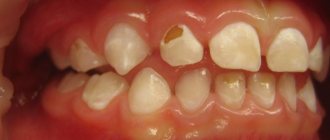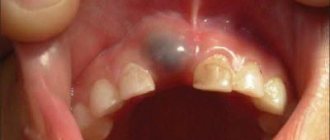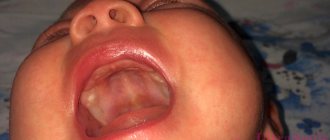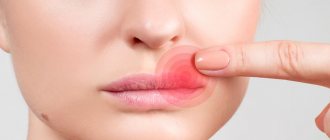Author of the article:
Soldatova Lyudmila Nikolaevna
Candidate of Medical Sciences, Professor of the Department of Clinical Dentistry of the St. Petersburg Medical and Social Institute, Chief Physician of the Alfa-Dent Dental Clinic, St. Petersburg
If you notice white spots on the enamel, this is a serious reason to see a dentist. Strange pigmentation may be a manifestation of demineralization or hypoplasia. Only a specialist can analyze the situation.
Demineralization of enamel in most cases is one of the first signs of the development of superficial caries. Weakened areas of the teeth lose important elements, becoming increasingly sensitive to the penetration of acids produced by bacteria. If you notice that parts of the tooth turn white when dry, this is initial caries or caries at the white spot stage. Seeing a doctor in time will help prevent its further development.
If the spots are glossy, it means there is an excess of fluoride in the body; they indicate fluorosis.
Another possible option is the development of enamel hypoplasia. This is not a carious lesion that appears due to a disruption in the formation of the enamel matrix. Hypoplasia usually develops under the influence of acute infections, rickets, various gastrointestinal problems and other diseases.
The mechanism of the problem
The health of dental units is ensured by a number of substances: these are vitamins A, C, E, D, group B, potassium, iron, iodine, magnesium, zinc and others. But the two main elements necessary to maintain the functionality of the jaw are calcium and fluoride.
Due to injury, work in a toxic industry, insufficient hygiene, or the accumulation of pathogenic bacteria on the surface of the enamel, it can lose useful compounds, which is why white spots, dots or stripes appear on the teeth (we will consider the result with a photo below).
What symptoms indicate caries in the spot stage?
It is very difficult to suspect caries at an early stage. The patient has no complaints of pain, discomfort while eating, and in fact, white spots are the only thing that indicates the beginning of the carious process. However, white spots are also characteristic of a number of other dental diseases, so the dentist’s goal is to correctly determine the cause.
The following signs help distinguish caries from other dental diseases:
- a white carious spot is usually a single one, whereas in other diseases the lightened areas are located on many teeth;
- A carious spot is white or cream-colored; it does not have clearly defined boundaries and has a smooth matte structure. In other pathologies, the spots most often have a clear border and yellowish pigmentation;
- caries in the spot stage most often forms on healthy enamel, while in other pathologies the tooth may already erupt with white spots.
It is almost impossible to distinguish between caries and other dental pathologies by symptoms without the help of a doctor. Moreover, not everyone is able to independently notice the change in enamel color. Therefore, it is recommended to undergo routine examinations at the dental clinic twice a year.
What does the pathology look like?
Initially, a very small speck is detected, which is difficult to notice with the naked eye. Over time, the focus of demineralization increases. The affected areas lose their natural shine because the crystalline structure of the substance covering the dentin is destroyed: it becomes porous, darkens and, due to a change in texture, turns into a reservoir for pathogenic microorganisms. At first, such microdestructions are painless, which indicates the need for visual control.
Most often, canines and incisors are affected, but sometimes pathology occurs on molars. It is important to notice it in time - the process is reversible with early diagnosis. If it is neglected, only radical methods of treatment will help (drilling, installing a large filling).
How does fluoridation treat caries in the spot stage?
The method helps provide the enamel with a sufficient amount of fluoride, a substance that maintains its strength and durability. The simple fluoridation method will require from 4 to 15 procedures. During each procedure, tooth enamel is coated with fluoride gel or varnish and left for 20 minutes. You must not eat or drink for 60 minutes after each procedure.
Deep fluoridation is considered more effective. To carry it out, you will need two drugs: a composition with fluorine, magnesium, copper and calcium hydroxide. When both compounds react, crystals are formed that seal the enamel structure. Thanks to the procedure, the concentration of fluoride ions in teeth increases approximately 5 times. Deep fluoridation is performed in one, less often - in 2-3 procedures.
With the help of fluoridation, enamel becomes more resistant to the destructive effects of organic acids, the activity of plaque bacteria and, accordingly, the rate of caries development is reduced, the healthy mineral composition of the enamel and the normal structure of hard tooth tissues are restored.
Often, when treating dental caries in the staining stage, methods of remotherapy and deep fluoridation are combined to achieve the best result.
Causes of problems in adults
White spots on tooth enamel can have different etiologies. To make an accurate diagnosis, the doctor examines and interviews the patient: he clarifies how oral care is carried out, whether there were injuries or other prerequisites for the appearance of foci of remineralization.
Initial caries
Whitish matte formations may indicate that the pathological process has begun and will soon make itself felt. The main reason for its development is poor hygiene (a person brushes his or her teeth irregularly, not thoroughly enough, or does not floss). The disease can also be caused by an excess of carbohydrate foods in the diet, especially fast carbohydrates (white bread, sweets). The resulting plaque becomes a breeding ground for bacteria and a good “future reserve” for the formation of caries.
If you start therapy at this stage, you can get by with non-invasive procedures, but the neglected process will lead to the destruction of dentin and, as a consequence, to pulpitis (a diagram of pulp damage can be seen in the illustration).
Traumatic impact
It is not so easy to injure the jaw in everyday life, but there is an exception: often the cause of white spots and stains on the teeth is wearing braces and splints. After removal of the orthodontic structure, foci of demineralization are found on the enamel surface; their occurrence could be avoided by observing dietary restrictions and hygiene.
The root cause of lesions under braces is the accumulation of food debris (especially acidic and carbohydrate-rich foods). This is why doctors advise regularly using an irrigator after installing jaw retainers. The surface areas under the locks are poorly moistened with saliva, which aggravates the situation.
Patients who have not been treated by an orthodontist also have white spots on their teeth. They are associated with a constant load:
- frequent consumption of seeds, nuts and other solid foods;
- bruxism (involuntary clenching of the jaws both during sleep and while awake).
Athletes involved in contact martial arts are also at risk.
Industrial or occupational fluorosis
He can be:
- streaked or spotted (mild form);
- chalky-mottled (moderate severity);
- erosive and destructive (severe course of the disease).
It occurs due to excess fluoride in the patient’s body and also leads to the appearance of chalky or transparent spots, specks and stripes on the teeth. The disease manifests itself in people who have worked for a long time in industries with high fluoride concentrations:
- glass, ceramic, cement;
- woodworking;
- oil producing
Workers of hazardous enterprises are recommended to regularly visit the dentist to identify pathology in the early stages and undergo timely treatment.
Hypoplasia
Many dental diseases in an already born baby are a consequence of the incorrect lifestyle of the expectant mother, lack of vitamins, and poor ecology.
White spots on a child’s baby (less often permanent) teeth often occur due to underdevelopment of the enamel. The foundation for its formation in children is laid during the period of intrauterine development - at the 7th week of pregnancy. Permanent incisors and molars are formed from 5 months to 7–8 years.
The most popular prerequisites for the spread of pathology:
- hypovitaminosis D in the mother;
- toxicosis;
- transferred rubella;
- frequent inflammation of the gastrointestinal tract;
- birth injury.
The problem cannot be prevented with a 100% guarantee, but you can make every effort to reduce the likelihood of its occurrence.
Black spots
Tooth degradation of this nature can have several causes. One of them is Priestley's plaque , most often caused by disturbances in the microflora of the children's intestines. As a result, both baby and molar teeth are destroyed by bacteria. The disease can only be treated with medication.
Black spots can also be caused by the development of caries. Blackening of teeth is often a consequence of a lack of calcium in the body. For prevention, you need to reduce the amount of sweets you consume.
In addition, you can increase calcium levels by giving your child more milk and using vitamin complexes prescribed by your dentist.
Much less often, but still possible, this pathology can be inherited from parents. Therefore, the child must have personal cutlery (at least a spoon and fork).
What diseases cause white spots on teeth to appear in children?
There are several options here:
- Lack of vitamins or minerals - in this case, in addition to visiting the dentist, it is worth visiting the pediatrician to take tests, prescribe medications or adjust the diet.
- Endemic fluorosis - most often occurs in babies living in industrial areas due to excessive saturation of drinking water with fluorides, if the expectant mother works in hazardous industries during pregnancy. In addition to medical intervention, you should, if possible, reconsider your lifestyle and eliminate the use of fluoridating pastes (they are not recommended for children under 4–5 years of age).
- The hypoplasia described above is a common cause of white spots found on dental photographs.
- Hardly started caries is the most common option.
The pathological process, which can develop in an adult for several years, in the case of a child often occurs rapidly and leads first to darkening of the stripes on the enamel, and then to the formation of large carious cavities. If the situation is neglected, the crown will collapse completely, leaving behind only a small black “hole” in place of the element. In addition to physiological reasons, this also occurs due to the difficulty of carrying out hygiene procedures, especially since older relatives often treat the baby with sweets (soda, sweets, fine flour bread). To avoid complications, it is recommended to visit the dentist with your child every 2-3 months.
Remineralizing therapy
White spots during caries are areas of enamel demineralization. It is possible to remove them if you restore the balance of minerals in tooth enamel. This can be done with the help of remineralizing therapy. It can be applied or carried out using a special mouth guard. In the first case, the tooth surface is covered with a concentrate for remineralization, in the second, a sealed mouth guard is used, individually made from a jaw cast. As prescribed by the doctor, the patient himself will fill the mouthguard with a remineralizing composition and put it on his teeth. Most often, solutions of calcium gluconate or glycerophosphate, as well as gels with calcium phosphate, are used for remotherapy.
Remotherapy helps remove caries in the form of stains, helps strengthen tooth enamel, replenishes the lack of minerals (mainly phosphates and calcium), reduces tooth sensitivity, prevents further development of the carious process, and preserves the natural healthy appearance of teeth.
The occurrence of pathology during the gestational period
Pregnancy is stress for the body and a time during which a woman requires an increased concentration of nutrients in food. The fetus needs minerals and vitamins for the correct formation of all systems and organs, so the expectant mother may experience a deficiency of them. It happens that foci of demineralization occur as a result of toxicosis, when, due to constant nausea, an overly acidic environment is created in the mouth.
If a white spot appears on a pregnant woman’s tooth, this means that it is worth visiting not only a dentist, but also a gynecologist to rule out metabolic disorders and alleviate unpleasant symptoms.
Diagnostics
Doctors do not recommend that parents do anything on their own. After all, spotting is a symptom of completely different diseases. You should contact a dentist who will conduct research and establish the correct diagnosis. To begin with, a visual examination of the oral cavity is performed. Then the dentist questions the parents in detail, collecting anamnesis. If there are indications, the child is sent for x-rays and other instrumental research technologies. If necessary, consultations with narrow specialists are provided. In addition to the pediatrician, the baby can be examined by an endocrinologist, immunologist, gastroenterologist, infectious disease specialist and other specialists.
Main symptoms of diseases
The signs of lesions vary, and the prognosis in the absence of timely medical intervention is also different. The final diagnosis should be made only by the attending physician, but the patient can, based on the nature of the pathological process, make an assumption about the root of the problem.
- If the enamel is injured, the person most likely knows about it - he recently removed braces or the jaw was mechanically damaged. Only the area on which pressure was applied or the part of the tissue hidden under the orthodontic structure is treated.
- If a child or adult has white spots on the front teeth (incisors) and molars, the reason is often the development of caries. Such neoplasms are localized randomly, but quickly progress, turn black, and deepen. The focus of the disease is single or few.
- With fluorosis, chalky or pale yellow stripes appear, which later darken.
- Hypoplasia is diagnosed in children and adolescents - and neighboring elements usually suffer.
Possible complications and consequences
Hypoplasia of tooth enamel without timely treatment contributes to the development of caries. An underdeveloped enamel layer does not protect dentin from the aggressive action of an acidic environment; the carious process quickly reaches the pulp and tooth root. Even in the absence of caries, teeth with thinned enamel and chips react with pain to cold, salty and sweet foods. Unpleasant yellow-brown spots disrupt the aesthetics of a smile. The enamel layer with a damaged structure quickly wears off and chips, and malocclusion develops.
Methods of treating pathology for initial caries
Inflammation at the initial stage is treated without the use of a drill and anesthesia: this is a painless manipulation that prevents damage to dentin, and the enamel can be considered healthy after treatment. In some cases, only the doctor at the appointment sees white spots on the teeth, so it is better to carry out these procedures immediately after identifying the problem.
Remineralization
Remotherapy is the process of artificially saturating tissues with micro- and macroelements. It is also indicated after prolonged use of splints or braces.
Calcium gluconate is most commonly used by dentists. A swab soaked in the solution is applied to the previously cleaned and disinfected jaw and left for exposure for several minutes. Sometimes the procedure requires repetition.
To ensure long-lasting results:
- brush your teeth with a soft brush and low-abrasive toothpaste;
- exclude too cold and hot, spicy, sour foods for a day or two.
Fluoridation
There is significantly more calcium in bone tissue than fluoride. But the latter plays a decisive role in the process of absorption of calcium compounds. The best results are obtained by alternating saturation procedures.
The doctor performs the operation manually using gel, varnish or tampons containing the desired element. After manipulation, it is not recommended to use medicinal pastes for 2 months.
Electrophoresis, infiltration, ozonation
These are more complex, but nevertheless non-invasive or micro-invasive processes that allow you to restore enamel that is beginning to decompose without pain relief using:
- microcurrents delivering the necessary substances (electrophoresis with calcium or fluorine ions);
- ICON lamps, thanks to them the desired material penetrates the pores of the surface, restoring the enamel layer (infiltration);
- gas that disinfects the entire dentition, ridding it of pathogens, followed by the use of a material that prevents the development of caries (ozonation).
The attending physician will offer the patient several options to choose from, and the final decision on what to do if white spots appear on the teeth is made jointly.
Sealing and silvering of enamel in children
Fissures are depressions and grooves on the chewing surfaces, thanks to which the jaws can grind food efficiently. Despite their usefulness, with insufficient care they become a source of inflammation and proliferation of microbes, especially in children who, due to their age, do not yet fully observe hygiene. Considering the fragility of the tissues of a child’s body, this leads to almost instantaneous development of caries. Sealing (filling) is done with a material similar to a filling material.
After manipulation, dentists recommend a coating - for example, with silver nitrate, a bactericide, which prevents further destruction of the units and keeps the oral cavity sanitized.
How is caries diagnosed?
The difficulty in diagnosing caries at an early stage is that the tooth does not cause any concern to the patient. At a dentist’s appointment, the diagnosis is made after a series of standard studies:
- Visual examination is the main diagnostic method by which an experienced dentist can immediately determine whether a patient has caries and how it can be treated.
- Drying of enamel. Another diagnostic method, the essence of which is that matte areas are more visible on dried enamel, which may indicate the initial stage of the carious process.
- Probing, that is, examining the surface of the teeth with a dental probe, helps to identify roughness and softened tissue that may be a sign of dental disease.
- Staining the surface of tooth enamel. To diagnose caries in the staining stage, teeth are sometimes stained with special dyes (for example, methylene blue). It leaves no marks on healthy enamel, but slightly stains carious spots.
After diagnosis, the dentist determines the appropriate treatment method for dental caries.
Therapy and restoration work for hypoplasia
For minor lesions, remineralization can be done; in complex situations, more serious intervention will be required. The problem is rarely localized to the molars and premolars. More often, incisors and canines are underdeveloped. Restoring the enamel in this case is impossible, and the only way out is aesthetic restoration. Depending on the degree of tooth decay, a veneer, crown or filling is placed on it, restoring color and shape.
You will learn in detail how you can restore the beauty of your smile using ceramics from the video:
Treatment
The process of eliminating a defect depends on the true cause of its manifestation. Therefore, there is no single recipe: the dentist proceeds from the individual characteristics of the patient and the degree of enamel damage. If the reason:
- When caries begins, a conservative approach is popular. Remineralization is necessary: saturation of the enamel with minerals using special ionizers, the use of physiotherapy (for example, exposure to ultrasound in parallel with the application of therapeutic compresses to the teeth). It is possible to apply a special preparation that closes the pores on the enamel and restores its smoothness and hardness. If the condition worsens, therapeutic treatment and installation of a modern filling are required.
- Hypoplasia. Silvering of teeth and also saturation with minerals and fluoridation are practiced. Dietary supplements containing calcium, phosphorus, and zinc are prescribed. If the application was late, then after adulthood, veneers or crowns can be used for camouflage.
- Fluorosis. Removing stains requires the use of special applications; electrophoresis is prescribed. It is necessary to drink only filtered, purified water and do not use fluoride-containing pastes. If part of the tooth is already destroyed, a filling is necessary.
- A consequence of wearing orthodontic structures (usually braces). When light spots are visible, procedures for local remineralization are applied. Toothpastes with fluoride are prescribed.
When white or already black spots on the teeth are a delayed consequence of an injury, then, depending on the nature of the damage, the doctor will prescribe conservative restoration (local remineralization, medication) or a radical intervention with reconstruction, splinting, or prosthetics will be required.
Preventing the appearance of white spots
If a person is already an adult, it is too late to prevent hypoplasia, but the development of other pathologies can be avoided. To do this you should:
- brush your mouth twice a day, floss after meals, use a medium-hard brush or soft, low-abrasive paste;
- undergo a preventive examination at the dentist 2 times a year, following all recommendations;
- eat well (eat enough vegetables and dairy products);
- in case of confirmed deficiency of nutrients (only in consultation with the doctor), use vitamin and mineral complexes.
You may also be interested in
PARODONTAL
Mouthwash ACTIVE
Unique two-part mouth rinse reduces bleeding and inflammation
More about the product
PLUS
Professional toothpaste REMINERALIZATION
Restores tooth enamel, reduces hypersensitivity of teeth and gums and accelerates regeneration of the oral mucosa
Learn more about the product
If the cause of chalky spots is fluorosis...
They can appear from the moment of teething. The inclusions are characterized by a gray or yellow-brown tint; they can be of different shapes and sizes and affect the teeth on any side. Fluorous spots and stripes, unlike carious ones, more often occur in groups and affect several teeth at the same time.
There is an opinion that the initial stages of fluorosis are not dangerous for the condition of the enamel. On the contrary, increased fluoride content strengthens hard tissues and makes teeth more resistant to caries. This opinion is true only for the initial stages of the disease; in moderate and severe stages, the enamel can be damaged, so the process cannot be left to chance.










